The Ultimate Guide to Low-Maintenance Front Yard Flower Beds
Everyone loves a beautiful front yard. It makes your house look welcoming. Great curb appeal feels good. But keeping those flower beds perfect takes work. A lot of work sometimes. Weeding, watering, trimming – it can feel overwhelming. What if you want that stunning look without spending every weekend gardening?
Good news. You absolutely can. We’re here to help you design gorgeous front yard flower beds that are also incredibly low maintenance. Forget sacrificing beauty for ease. Forget spending hours you don’t have.
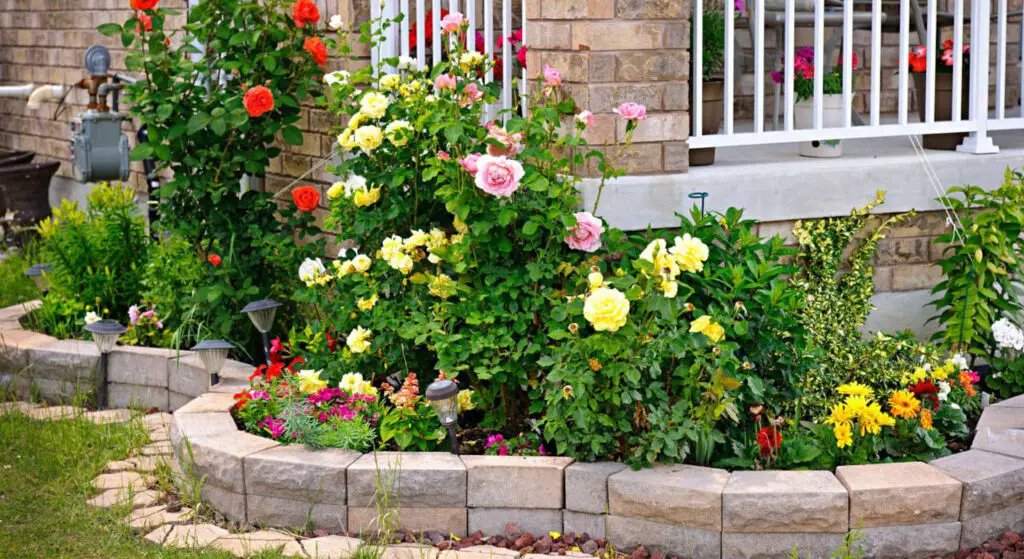
Get ready for practical tips anyone can use. We’ll look at easy-care plants that thrive. Simple design ideas will make a big impact. And we’ll even cover budget-friendly ways to get the look you want. Let’s create a front yard you love looking at, without all the fuss.
Key Principles of Low-Maintenance Flower Bed Design
Want easy-care flower beds? Start simple. Good planning makes all the difference. Think before you dig. A little thought now saves lots of effort later. Keep your designs clean and uncluttered for the easiest upkeep. Front yard flower beds simple is the goal.
Importance of Simplicity and Planning

Don’t try to do too much at once. A few well-chosen elements look better than a jumbled mess. Simple shapes are easier to maintain. Planning helps you choose the right plants for your spot. Consider sunlight, soil, and how much space you really have. A clear plan prevents mistakes and wasted work. It sets you up for success from day one.
Using Defined Spaces

Clearly marked edges make beds look tidy. They also make mowing easier. Use materials like stone, brick, metal edging, or even deeply cut trenches. These borders keep grass out of your beds. And they keep your mulch or soil in place. Defined spaces look intentional and polished. Low maintenance front yard landscaping design flower beds often feature strong borders. Edging prevents that messy, creeping look.
Layering Strategy
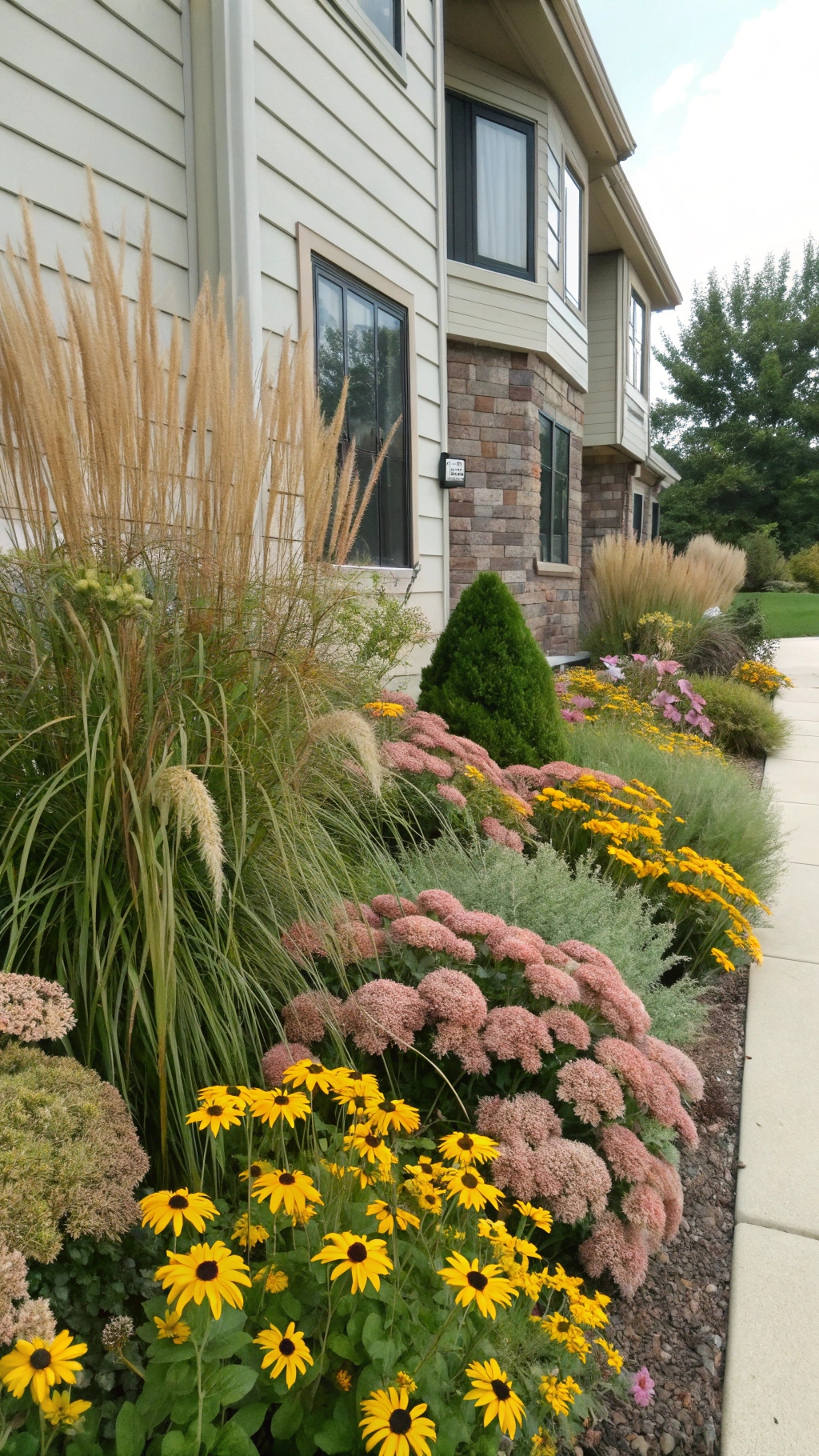
Think like you’re arranging a group photo. Put taller plants in the back. Place medium-sized plants in the middle. Put the shortest ones right up front. This layering makes sure every plant gets seen. It also creates a full, lush look without overcrowding. Taller plants won’t block sun from shorter ones. Everything has its place. Simple. Effective.
Why Spacing Matters
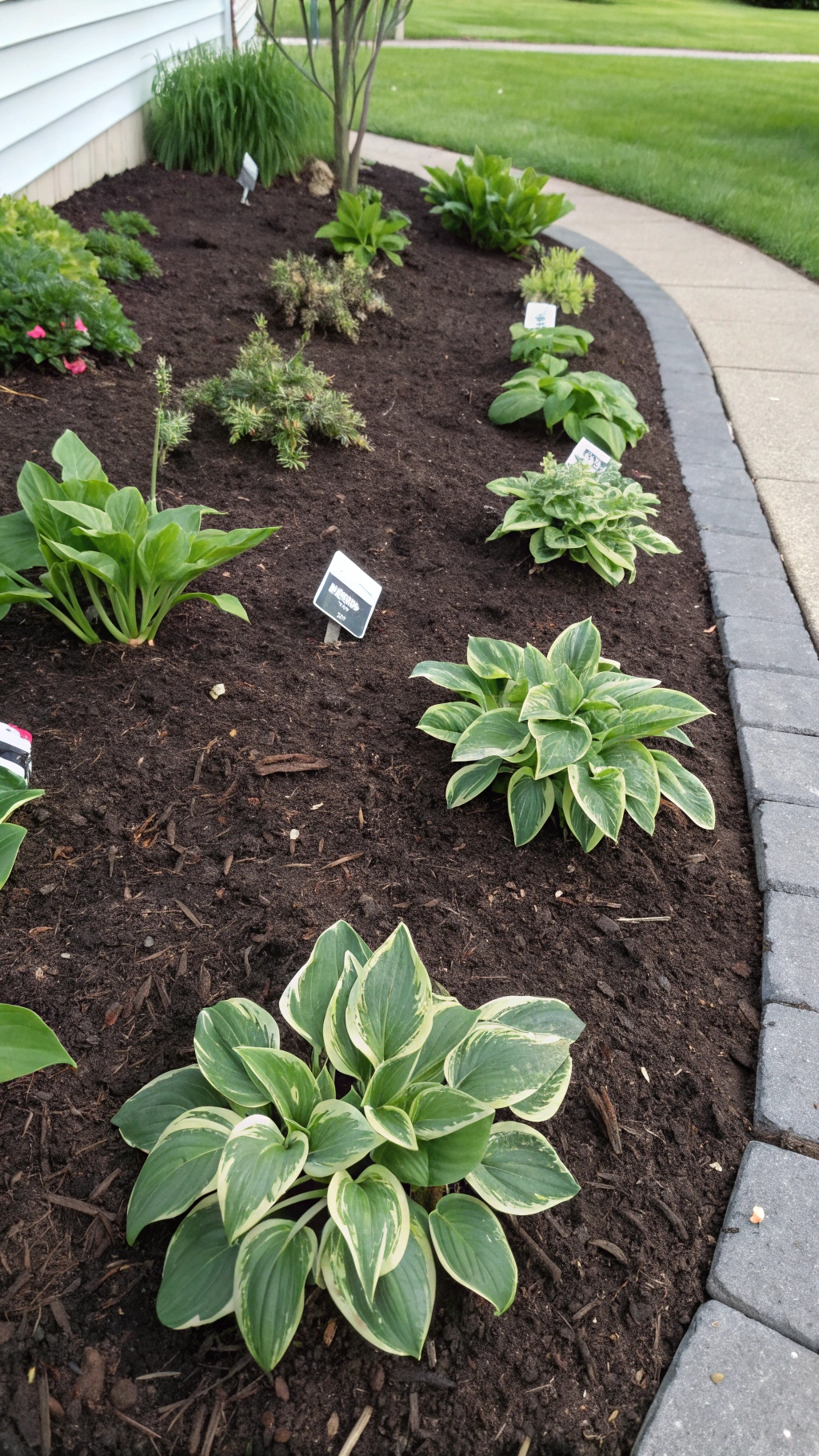
Give your plants room to breathe. And room to grow. Planting too close together causes problems. Plants compete for water and light. Air can’t circulate well, inviting diseases. Proper spacing means less pruning later. It also makes weeding much easier. Fewer plants, placed well, often look better. Front yard flower beds easy means not packing things in too tightly. Check plant tags for mature size information.
Easy Front Yard Flower Bed Ideas
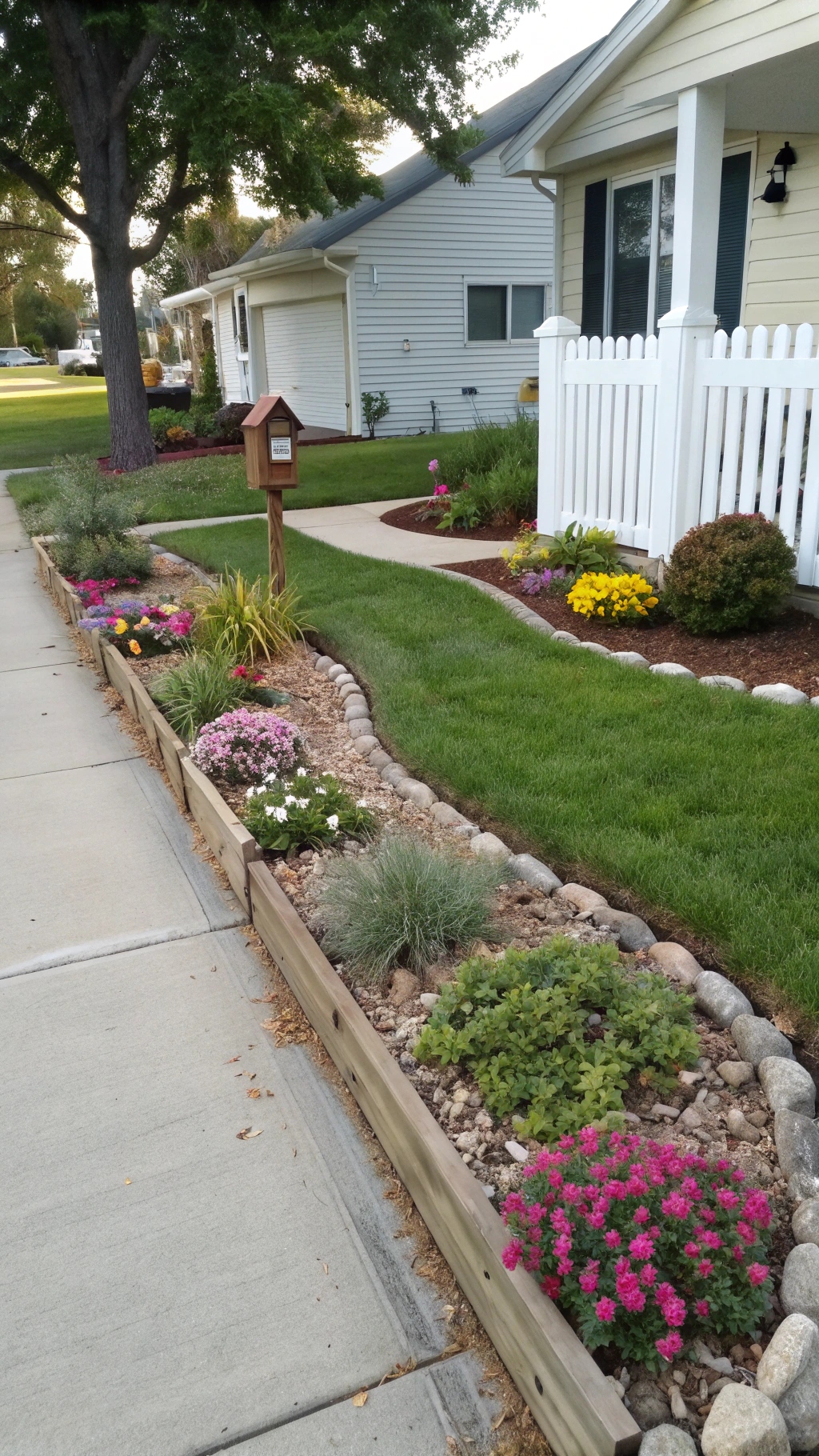
Creating beautiful flower beds doesn’t need to be hard work. Focus on designs that naturally reduce chores. Think less watering, minimal weeding, and infrequent trimming. Simple shapes and smart placement are your best friends here. Aim for layouts that are easy to access and manage.
Creating Flower Beds That Require Minimal Watering, Weeding, and Trimming
Choose drought-tolerant plants once they’re established. Group plants with similar water needs together. Use a thick layer of mulch (we’ll talk more about this later!). Mulch blocks weeds and keeps soil moist. Select plants that naturally stay compact. Or choose ones that look good without constant pruning. Avoid plants known to spread aggressively unless you want them to fill an area.
Simplified Layouts: Rectangular, Curved, and Raised Beds
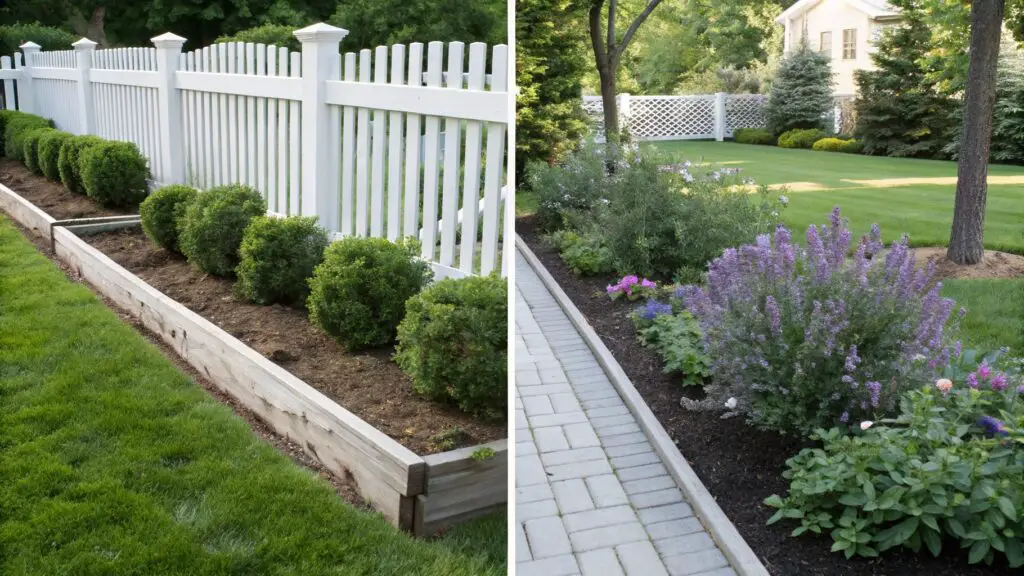
Simple shapes work best for low maintenance. Rectangular beds are easy to define and mow around. They fit well along houses, fences, or driveways. Curved beds offer a softer look. Gentle curves are easier to maintain than tight squiggles. Raised beds bring the garden up to you. They offer great drainage and are super easy to weed. Building them can be an easy front yard landscaping budget flower beds project.
Beds Along Walkways or Driveways
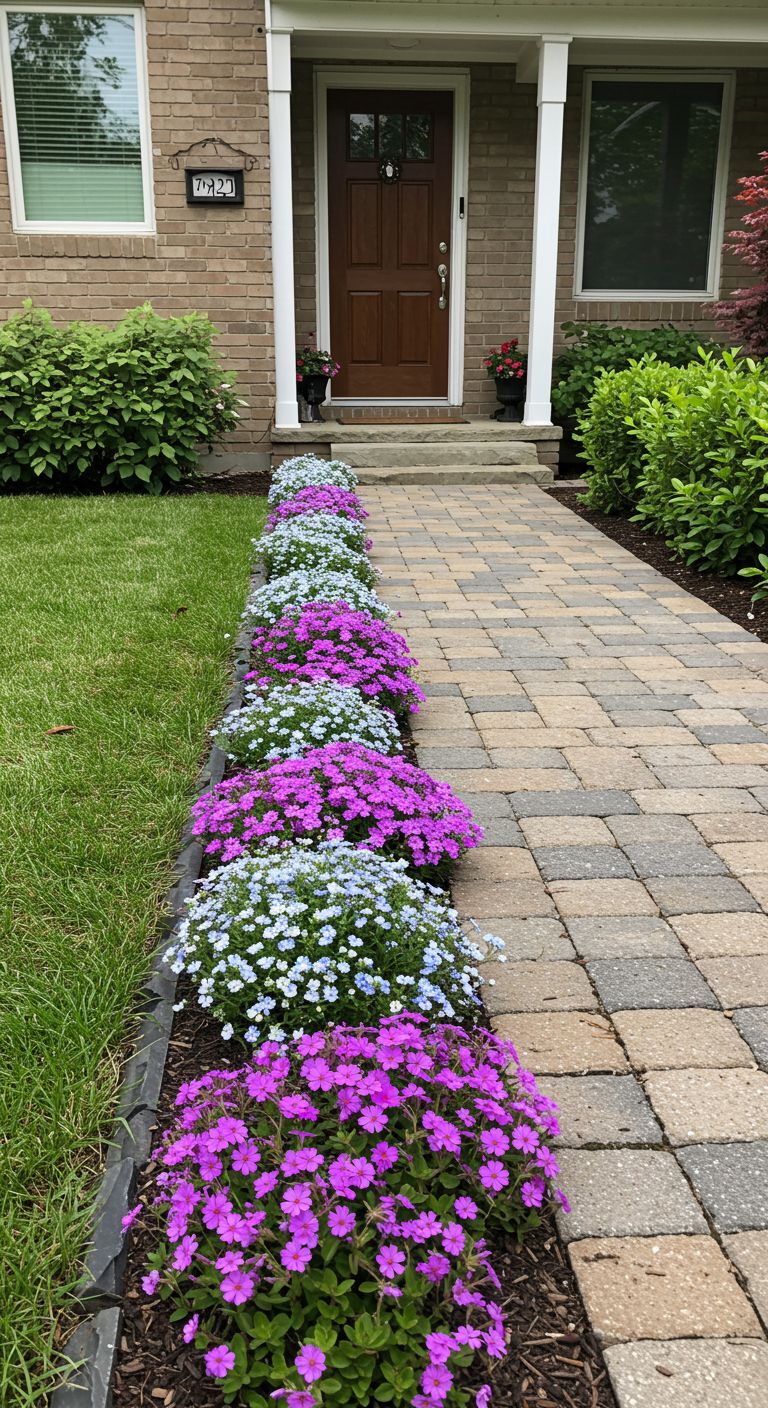
Using the edges of paths or driveways is smart. These hard surfaces create one solid border already. It makes defining the bed shape simple. Planting along walkways adds color and interest right where people see it. Choose low-growing plants near paths. Avoid anything too tall or floppy that might obstruct the way. These beds guide visitors to your door. And they are often very easy to reach for care. This makes front yard flower beds easy to manage.
Low-Maintenance Flower Beds Against the House

Planting next to your house looks great. It softens the hard lines of the foundation. But you need to be smart about it. The wrong plants or placement can cause problems. Moisture near foundations is a big concern. Let’s look at creating beautiful, safe, and easy beds right against your home. Making good choices here protects your biggest investment.
Importance of Low-Maintenance Choices Near Home Foundations
Why focus on easy-care plants here? Water. Plants too close to the house can trap moisture against the foundation or siding. Some plant roots can be aggressive. You want plants that won’t damage structures. Front yard flower beds against the house low maintenance landscaping prioritizes safety and simplicity. Constant watering or digging near foundations is best avoided. Choosing wisely prevents future headaches.
Tips on Correct Spacing and Moisture Control
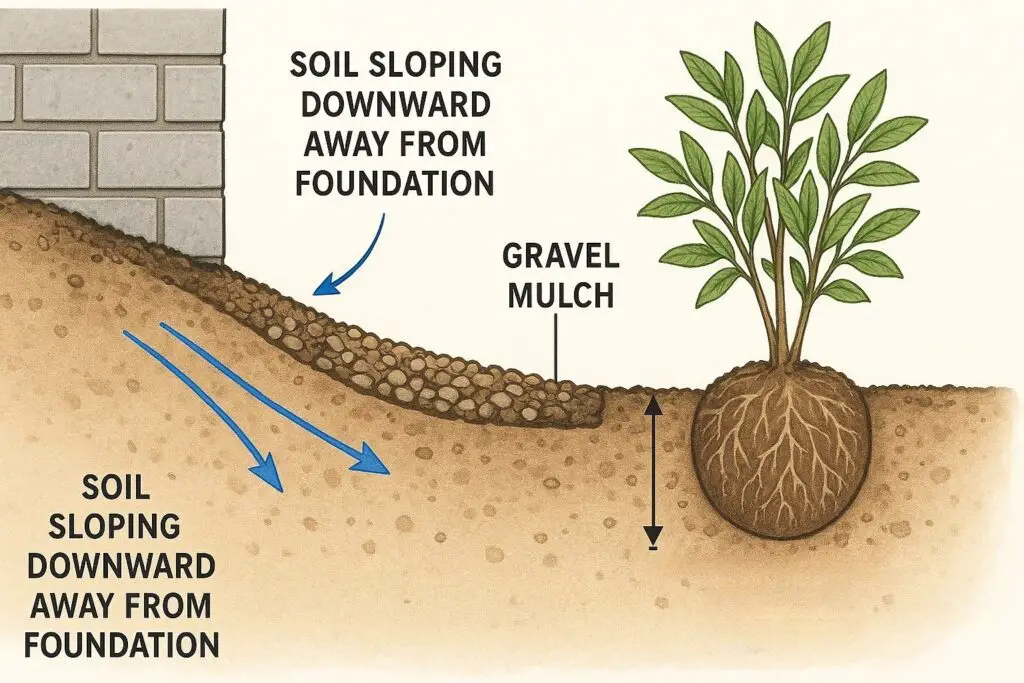
Give your house some breathing room. Keep plants at least a foot away from the siding. Maybe even more for larger shrubs. Ensure the soil slopes away from the foundation. Water should drain outwards, not pool against the house. Avoid plants that need constant watering right next to the building. Consider using gravel or stone mulch near the foundation. It dries quickly and doesn’t hold moisture like wood mulch. Good airflow is key.
Ideal Plant Types
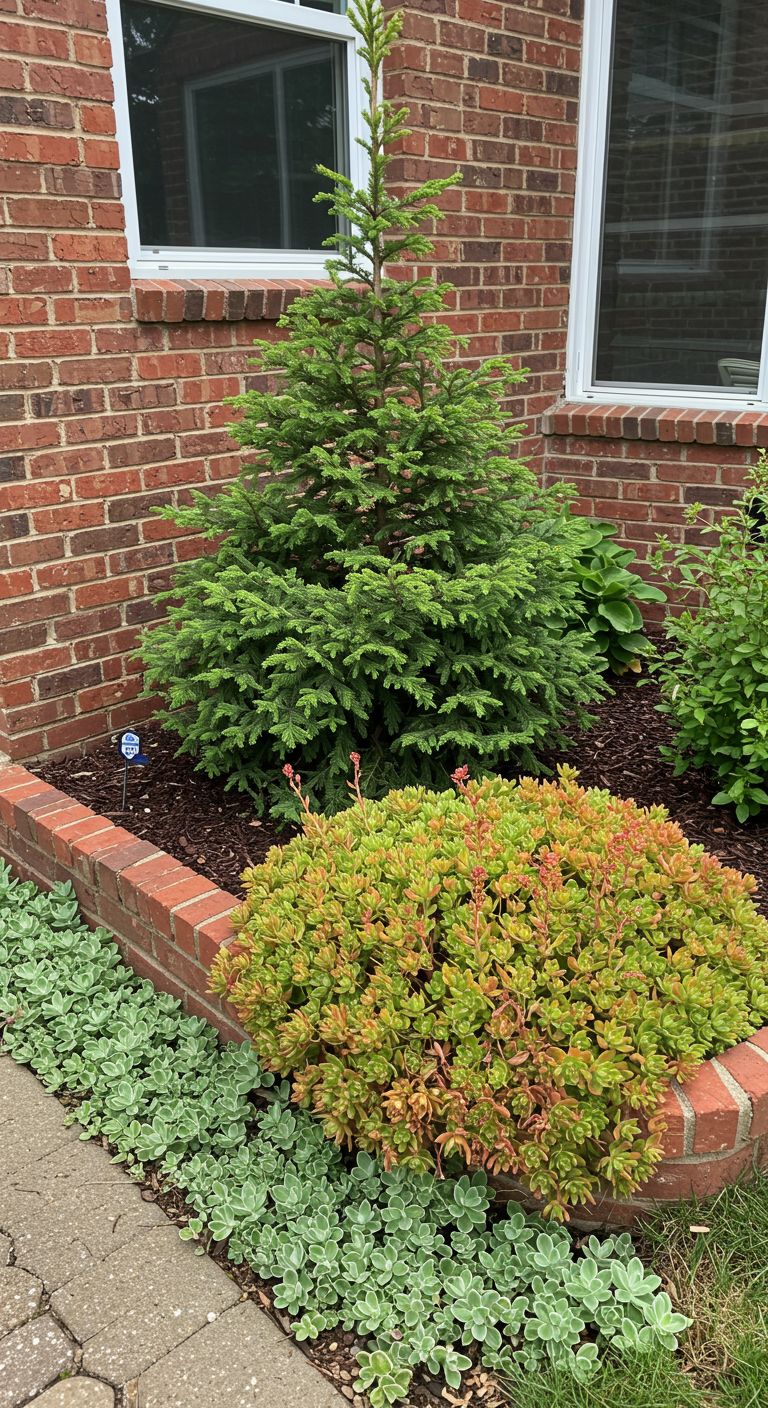
What works well against the house? Drought-tolerant perennials are great choices. Think plants that handle dry spells gracefully. Many evergreen shrubs offer year-round structure without needing much fuss. They also don’t drop leaves against the house each fall. Low-growing groundcovers can fill space nicely. Look for varieties that aren’t invasive water-hogs. Front yard flower beds against the house low maintenance easy often feature these types.
Best Low-Maintenance Plants for Front Yard Flower Beds
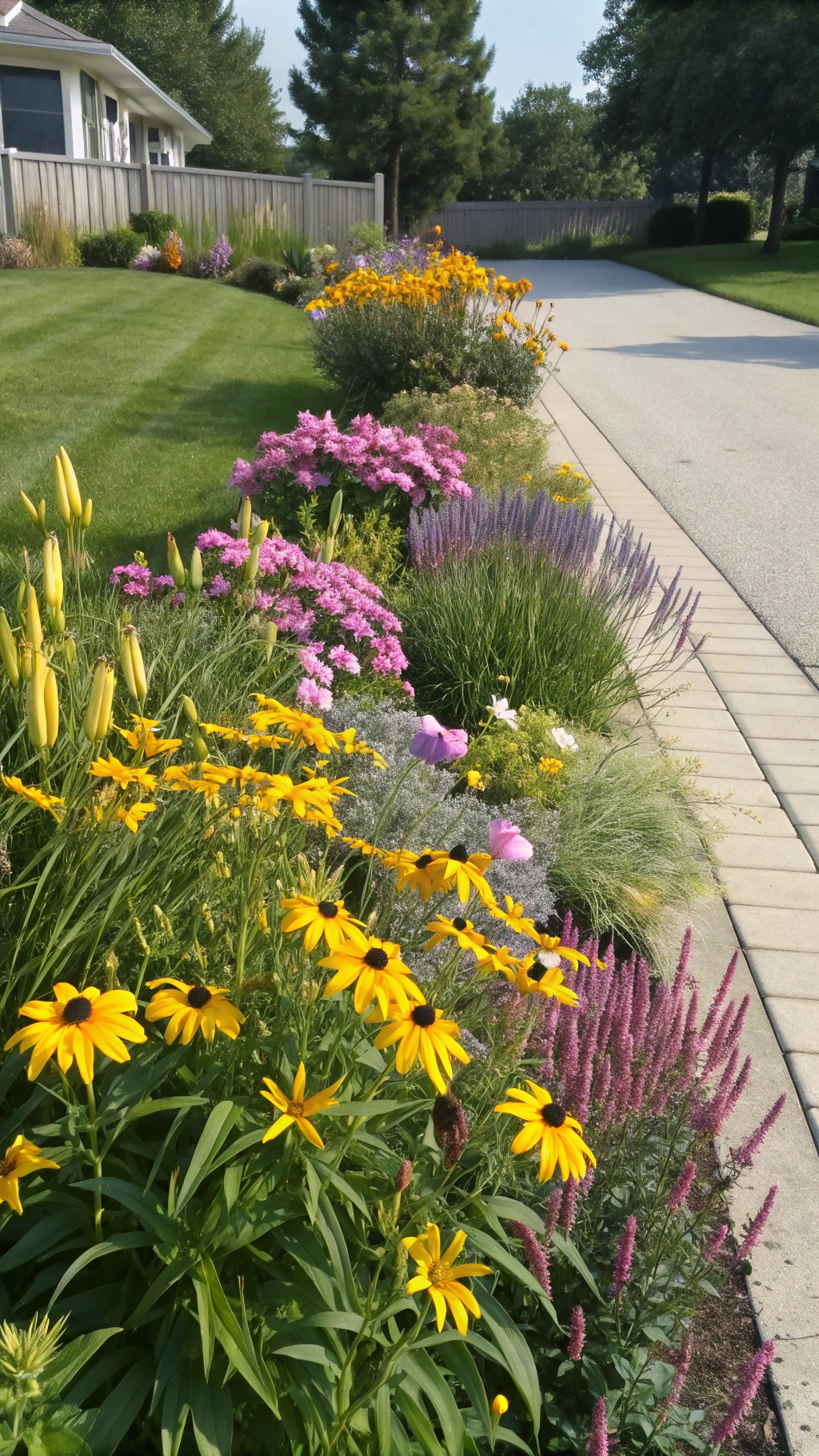
Choosing the right plants is the secret weapon for easy gardening. You want plants that are tough. Plants that look good without constant pampering. Hardy varieties can handle your local climate extremes. Selecting resilient plants means less worry about pests, diseases, or weather damage. Let’s explore some fantastic options for beautiful, front yard flower beds low maintenance style.
Perennials: Daylilies, Black-eyed Susans, Sedums, and Coneflowers
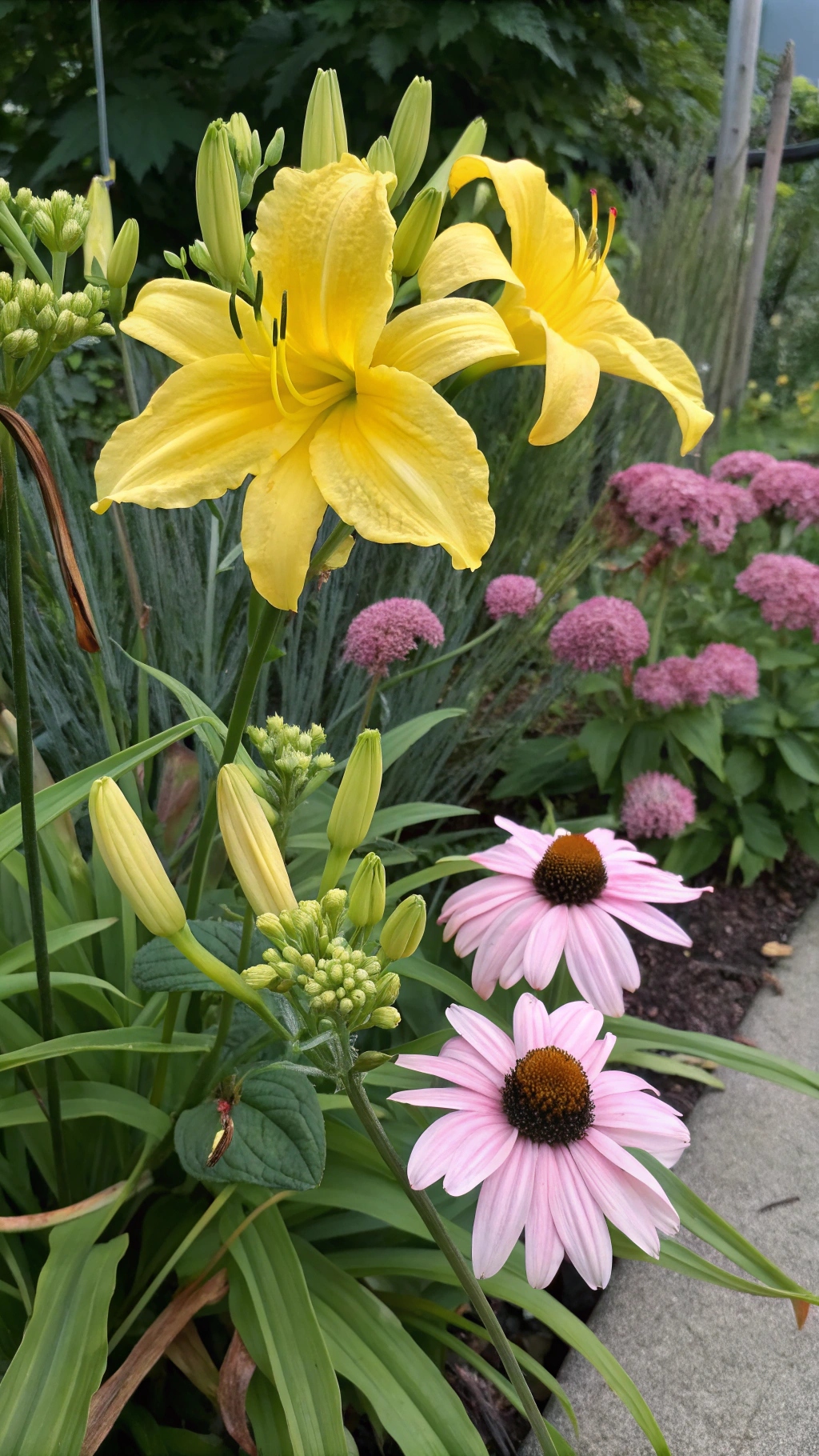
Perennials come back year after year. Plant them once, enjoy them for seasons. Daylilies (Hemerocallis) are champions of easy care. They tolerate various conditions and bloom profusely. Black-eyed Susans (Rudbeckia hirta) offer bright, cheerful yellow flowers. They love sun and handle neglect well. Sedums, especially upright types like ‘Autumn Joy’, provide late-season interest and tolerate drought. Coneflowers (Echinacea) boast beautiful blooms, attract pollinators, and are very hardy. These are reliable choices.
Shrubs: Dwarf Boxwoods, Spirea, and Evergreen Junipers
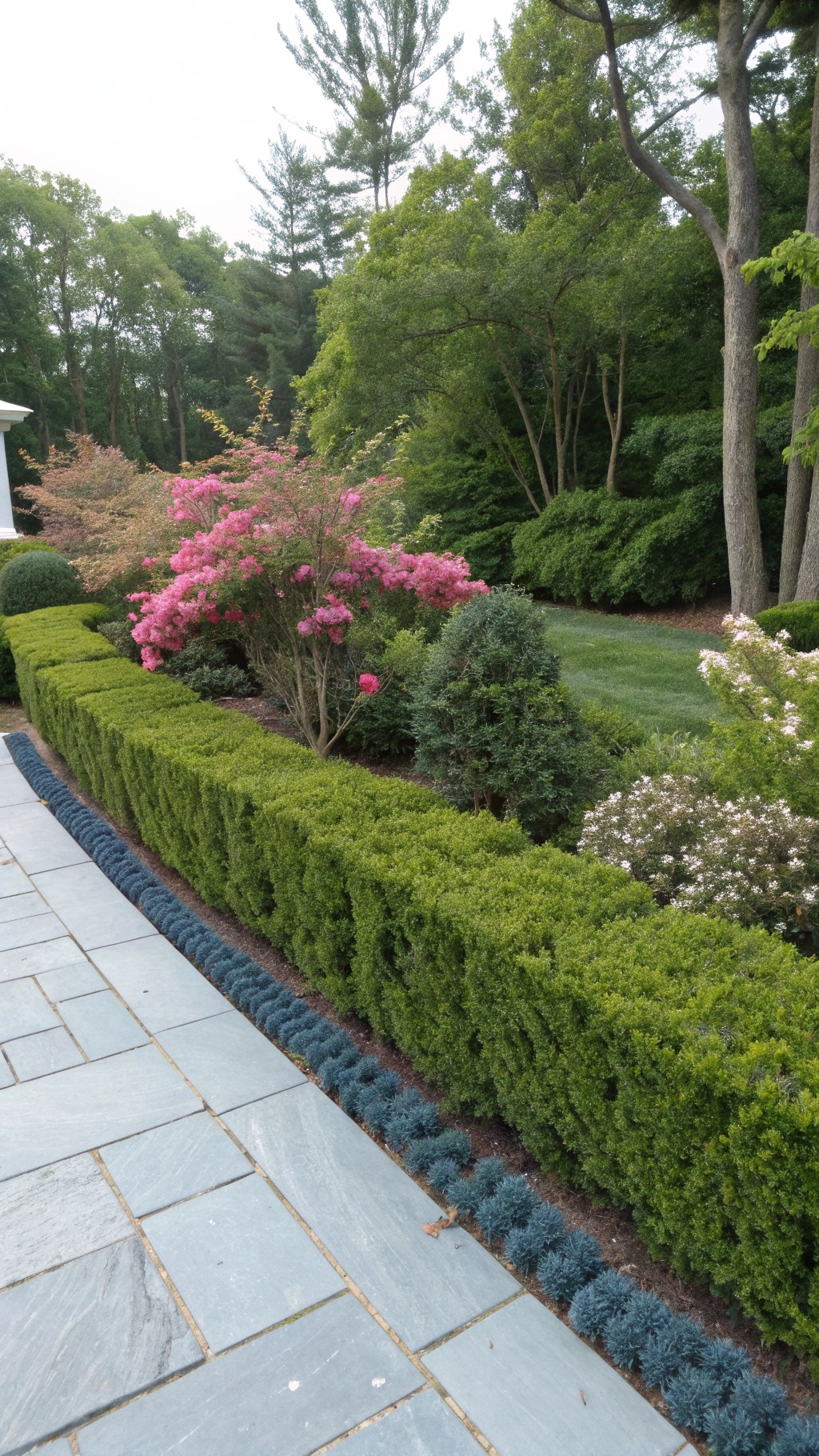
Shrubs provide structure and year-round interest. Dwarf Boxwoods offer classic green shapes. They are slow-growing and need minimal pruning to stay tidy. Spirea bushes, like ‘Goldflame’ or ‘Little Princess’, bloom beautifully. Many varieties stay compact naturally. Evergreen Junipers come in many shapes and sizes, from low groundcovers to upright forms. They are incredibly tough, handling heat, cold, and drought. These anchor low maintenance landscape ideas front yard shrubs flower beds.
Groundcovers: Creeping Thyme, Vinca Minor, and Sedum ‘Angelina’
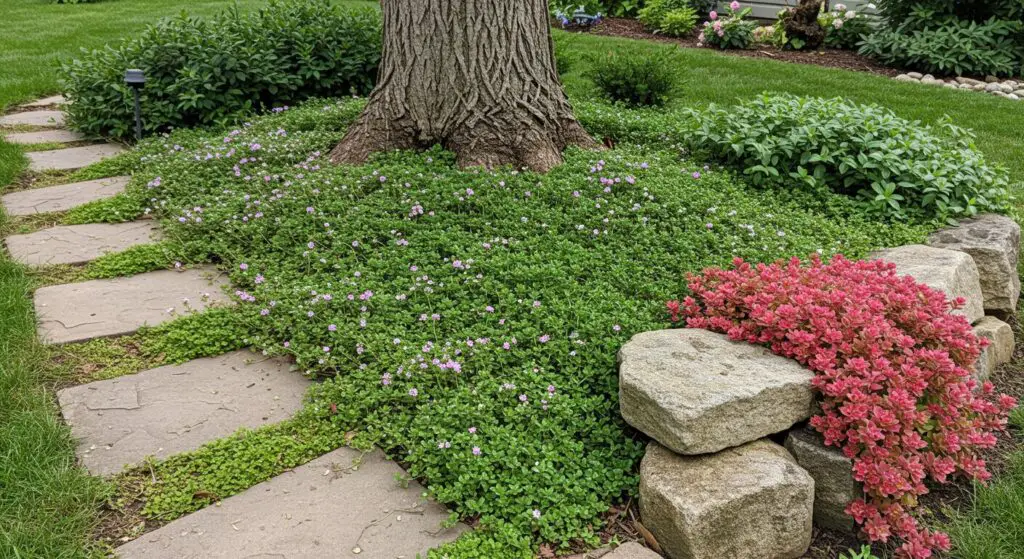
Groundcovers are amazing problem solvers. They suppress weeds by covering the soil. Creeping Thyme is fragrant, walkable in light traffic areas, and produces tiny flowers. It loves sun and well-drained soil. Vinca Minor (Periwinkle) has glossy evergreen leaves and pretty blue flowers. It tolerates shade well but can be vigorous. Sedum ‘Angelina’ offers stunning chartreuse, spiky foliage. It spreads readily in sunny, dry spots and looks fantastic cascading over edges. Easy groundcovers reduce mulching needs.
Smart Shrub Choices for Low-Maintenance Landscaping
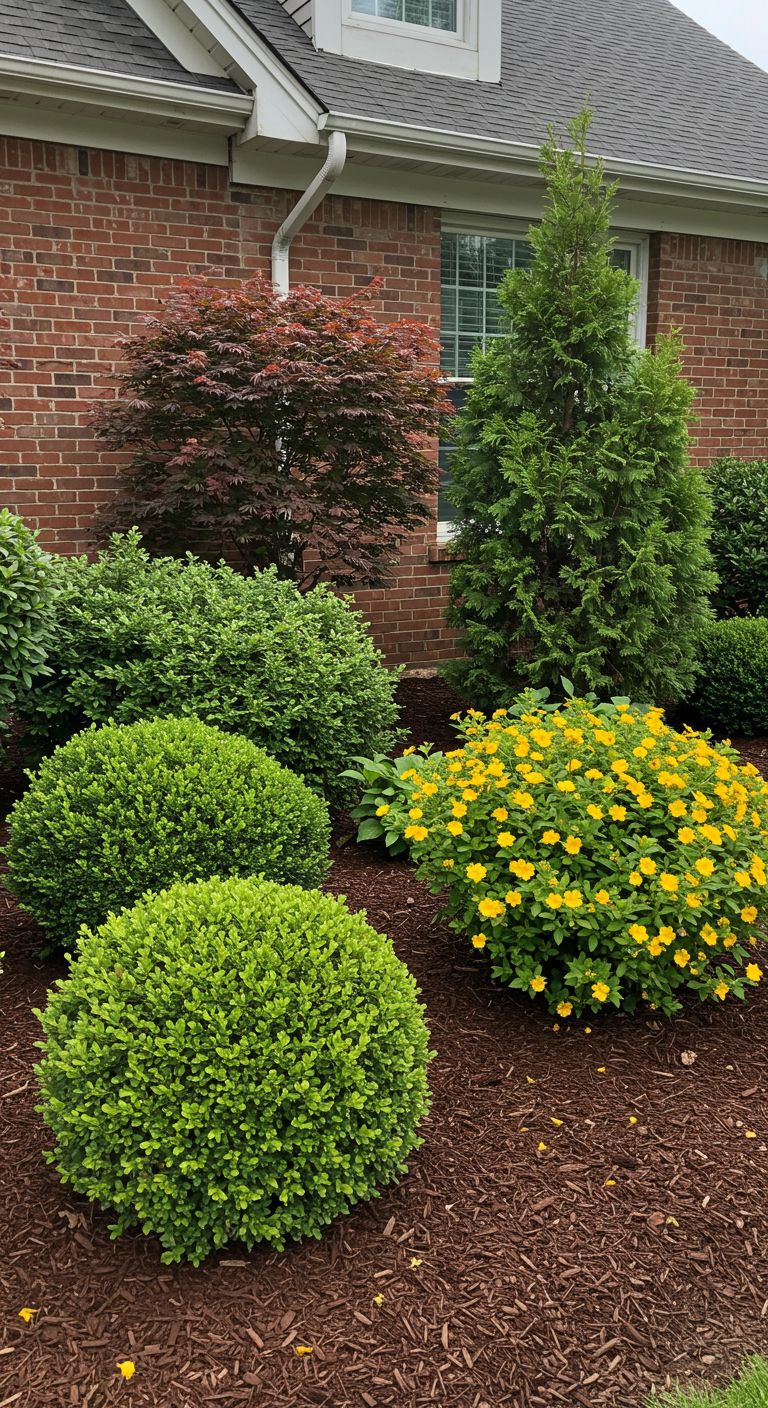
Shrubs are fantastic tools for easy gardening. Think of them as the backbone of your flower bed. They fill space beautifully. More shrub coverage means less room for weeds. It also reduces the amount of ground you need to mulch each year. Smart shrub choices form the core of low maintenance landscape ideas front yard shrubs flower beds. They provide lasting structure with minimal fuss.
Using Shrubs Effectively to Reduce Gardening Workload
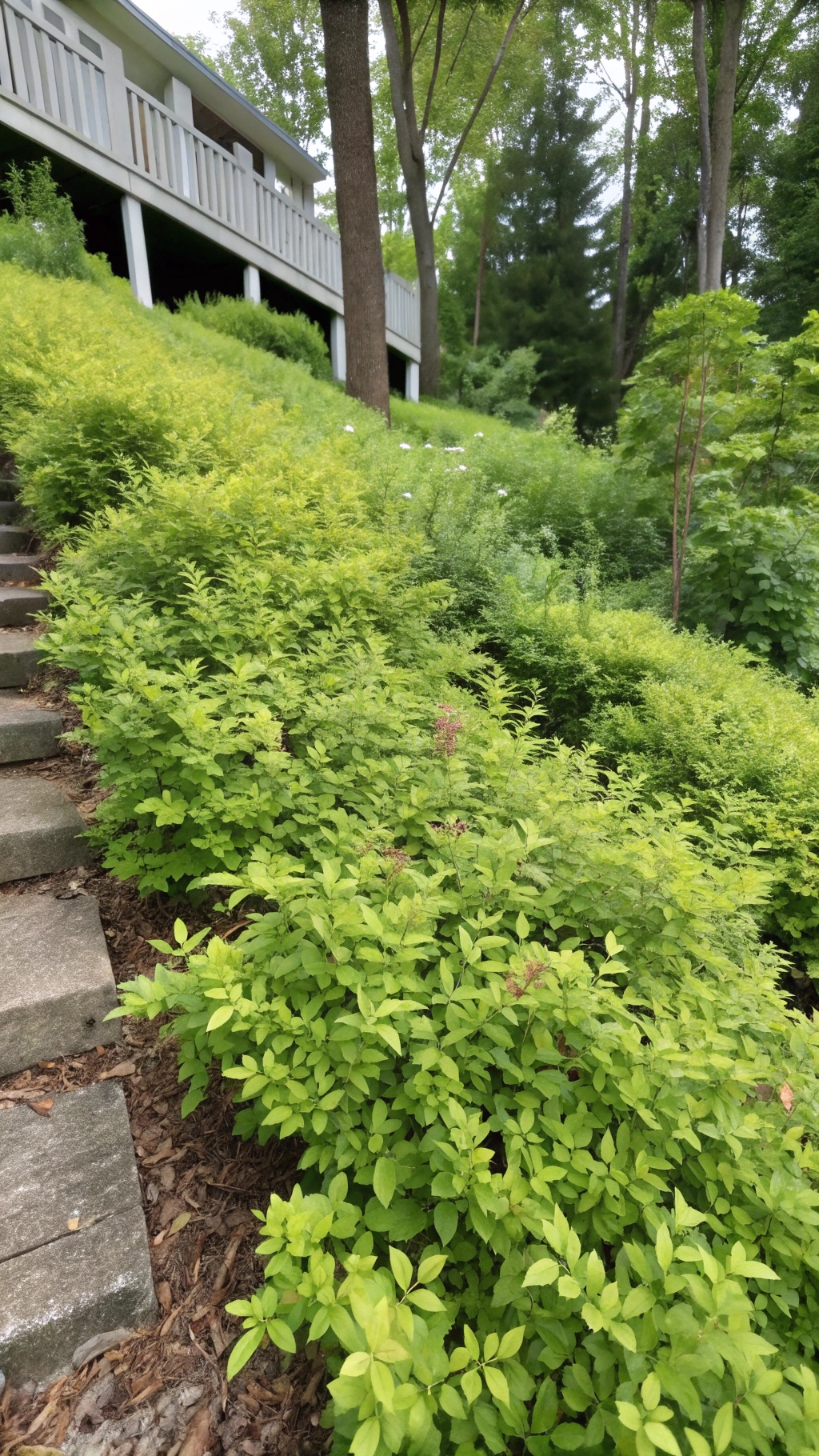
Planting shrubs means less annual planting. They stick around for years. Choose varieties that naturally stay the size you want. Avoid shrubs that need constant trimming to keep them in check. Grouping shrubs together creates a ‘green mulch’ effect. Their leaves shade the soil, helping keep weeds down. Fewer empty spaces mean fewer opportunities for unwanted plants to sprout. It’s a simple way to work smarter, not harder.
Evergreen Versus Deciduous Shrubs: Pros and Cons for Easy Upkeep
Evergreen shrubs keep their leaves all year. Think Boxwoods, Junipers, Hollies, Yews. Pro: They provide constant color and structure, even in winter. Con: Some can look a bit static; occasional pruning might be needed to maintain shape.
Deciduous shrubs lose their leaves in fall. Think Hydrangeas, Spirea, Azaleas, Lilacs. Pro: Many offer stunning flowers or great fall color. Con: You’ll have leaves to rake up in autumn. They look bare in winter.
For easiest upkeep? A mix often works well. Evergreens provide the winter bones. Deciduous shrubs add seasonal excitement.
Highlighting Specific Easy-Care Shrubs: Hydrangeas, Japanese Holly, Yew, and Azaleas

Not all shrubs are created equal for low maintenance. Some Hydrangeas, like Panicle types (‘Limelight’, ‘Quick Fire’), are very reliable. They bloom on new wood, so tricky pruning isn’t required. Japanese Holly looks like Boxwood but often resists pests better. It’s a tough evergreen. Yew (Taxus) is another super-hardy evergreen. It tolerates sun or shade and needs little care once established. Many Azaleas, especially native varieties or modern hybrids like Encore® Azaleas, offer spectacular blooms without demanding constant attention. Research specific varieties suited to your zone.
Mulching Magic: Easy Maintenance Solution
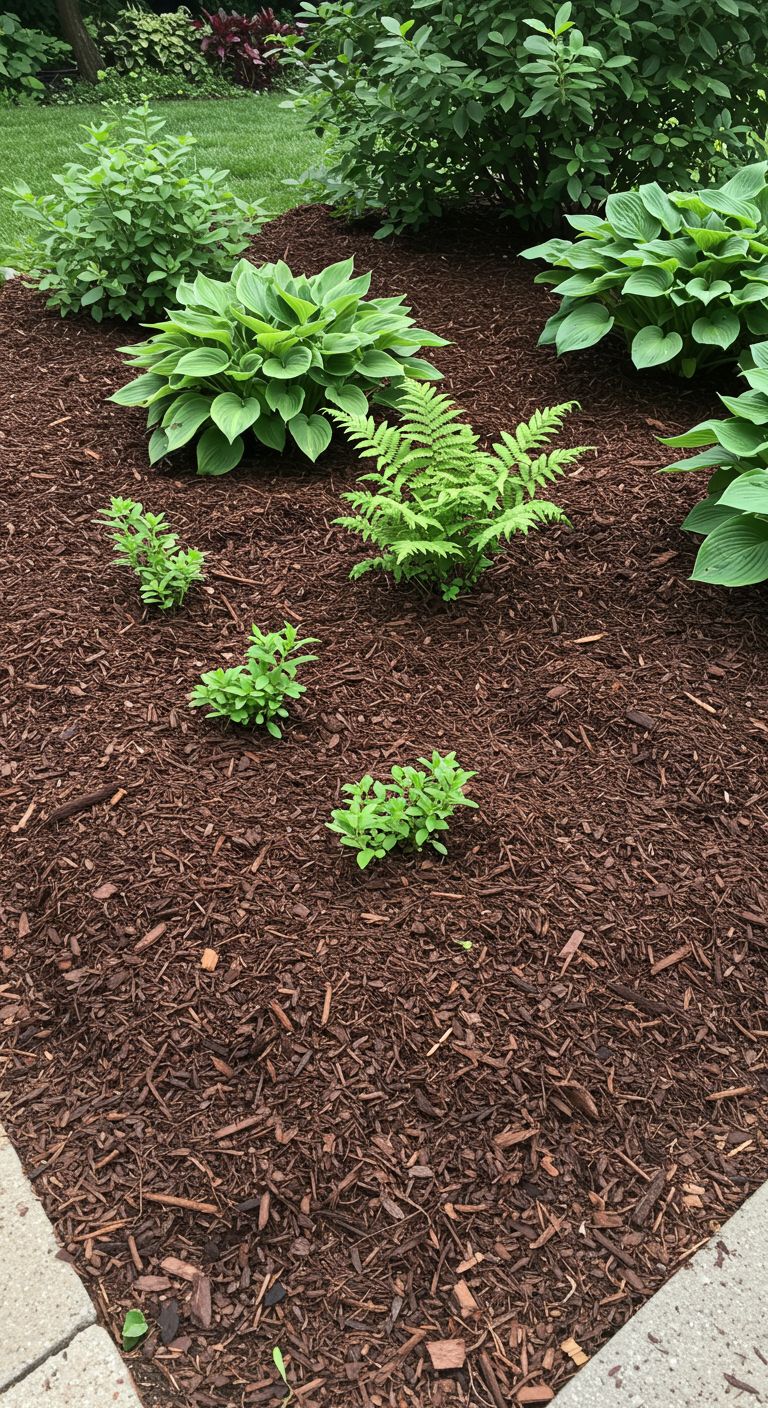
Let’s talk about mulch. It might be the single best trick for low-maintenance beds. Covering the soil surface with a layer of material works wonders. It instantly makes your beds look neater. And the benefits go way beyond looks. Proper mulching dramatically cuts down on garden chores. It’s a simple step with huge payoffs for front yard flower beds low maintenance.
Why Mulching Significantly Reduces Maintenance
How does mulch help? First, it blocks sunlight from reaching weed seeds. No light means fewer weeds sprout. This is huge for weed suppression. Second, mulch acts like a blanket. It helps the soil hold onto moisture retention. Less water evaporates, so you water less often. Third, it moderates soil temperature. Keeps roots cooler in summer and warmer in winter. Healthy soil means happy, low-care plants.
Types of Mulch: Bark Chips, Wood Mulch, Gravel, and Decorative Stone
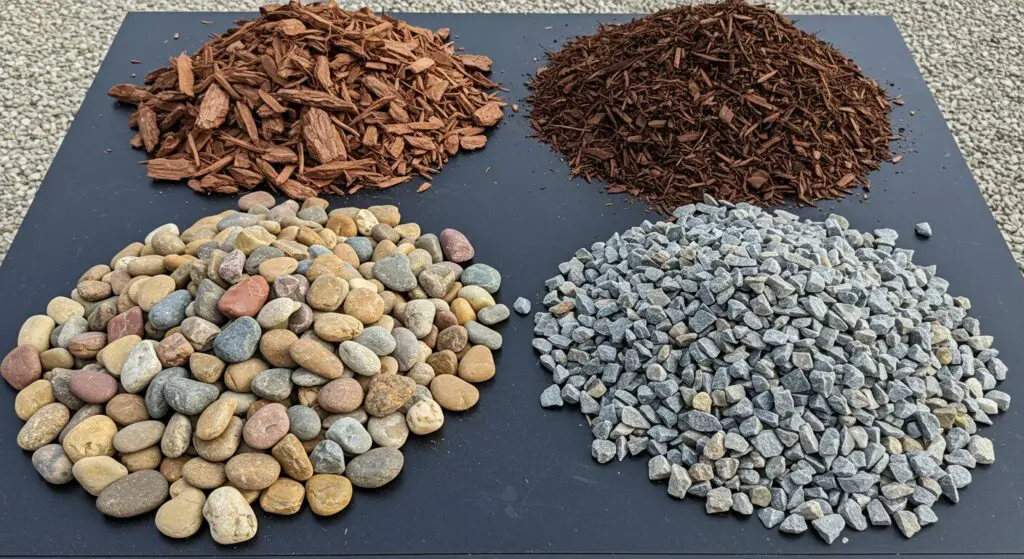
You have options! Organic mulches break down over time, improving the soil. Bark chips last quite a while. Shredded wood mulch looks neat and comes in various colors (brown, black, red). Inorganic mulches don’t decompose. Gravel or pea stone works well, especially near foundations or for a modern look. Decorative stone like river rock adds texture. Choose based on the look you want, your budget, and how often you want to reapply. Organic mulches need topping up every year or two. Stone lasts much longer but doesn’t feed the soil.
Application Tips for Maximizing Weed Suppression and Moisture Retention
Apply mulch correctly for best results. Aim for a layer 2 to 3 inches deep. Too thin, and weeds push through. Too thick, and water might not reach the soil. Keep mulch slightly away from plant stems and tree trunks. Don’t pile it right against them like a volcano. Leave a small gap. This prevents rot and keeps pests away. Apply mulch to bare soil after weeding. A fresh layer makes everything look tidy and makes those front yard flower beds simple to manage.
Low-Maintenance Flower Beds on a Budget
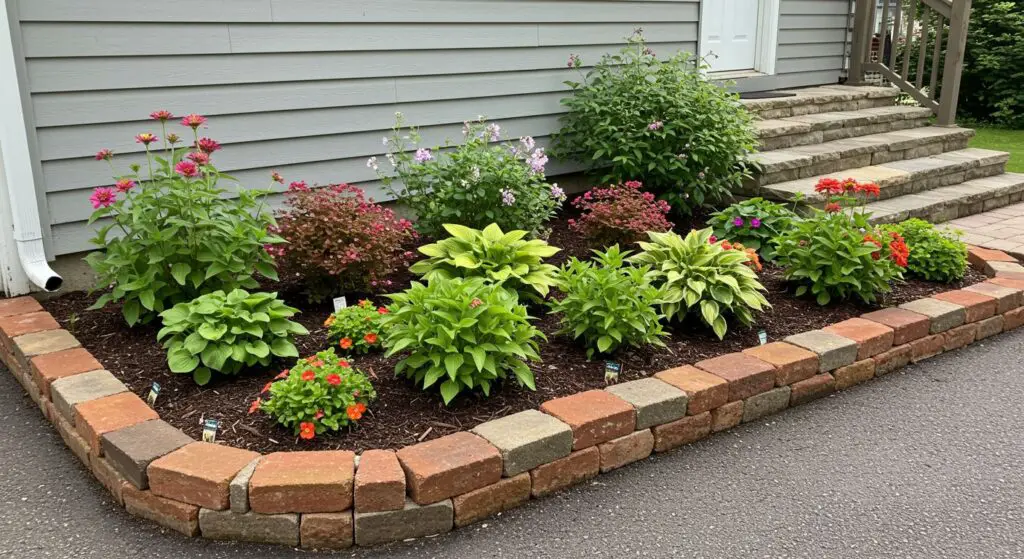
Want a gorgeous front yard without spending a fortune? You can absolutely do it. Creating attractive flower beds doesn’t require emptying your wallet. Smart choices make all the difference. Think resourcefully. Look for savings. An easy front yard landscaping budget flower beds approach focuses on value and simple solutions. Beauty on a budget is totally achievable.
Tips for Achieving an Attractive Flower Bed Without High Costs
Look for deals and be patient. End-of-season sales at nurseries offer big discounts. Consider buying smaller plants. They cost less and often establish better than large, root-bound ones. Share plants with neighbors or friends. Dividing existing perennials gives you free plants. Use materials you already have for edging or decoration. A little creativity goes a long way. Focus spending on healthy soil and good mulch.
DIY Edging: Affordable Materials Such as Stones, Bricks, or Reclaimed Wood
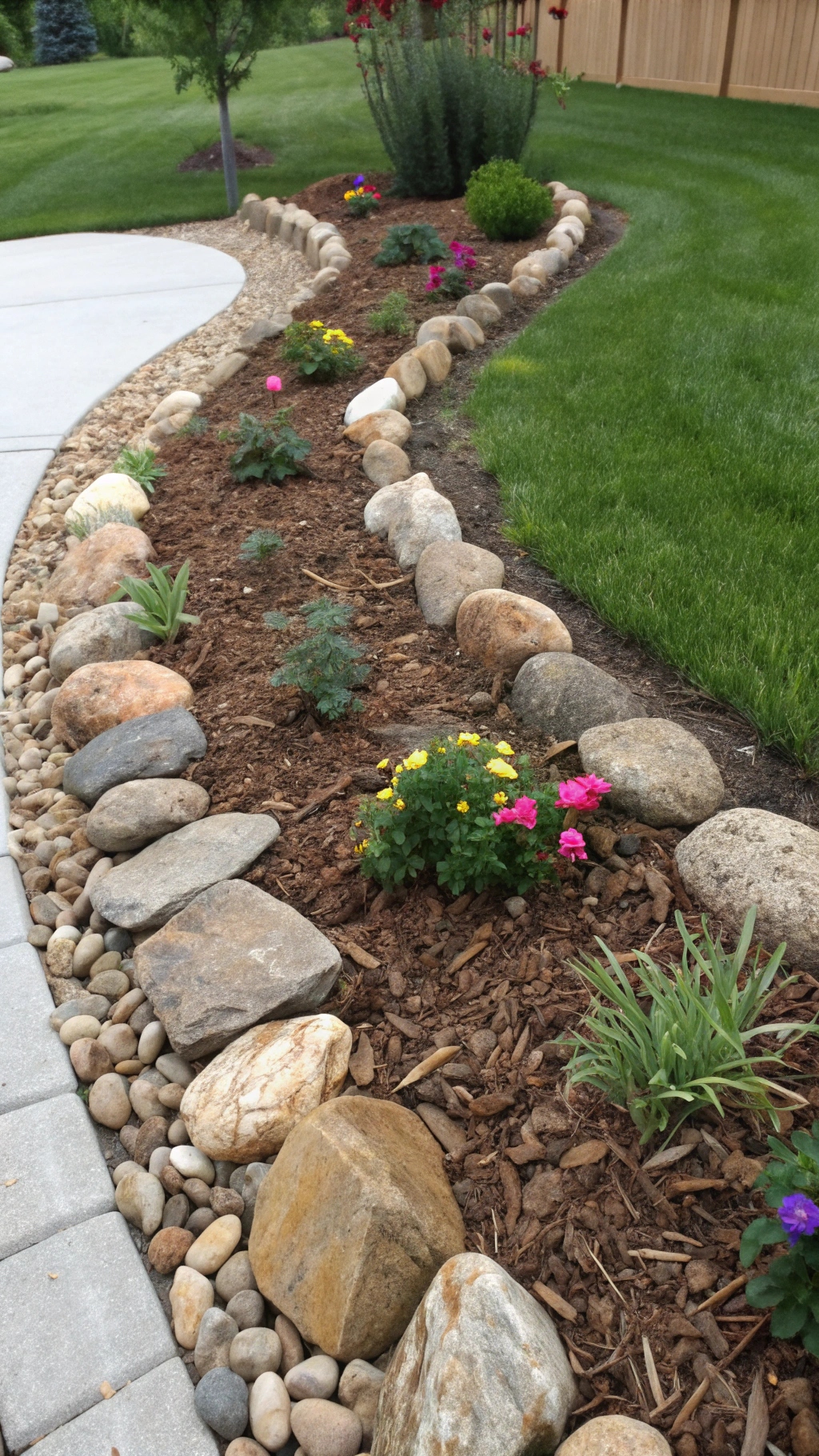
Defined edges make beds look sharp. But fancy edging can be pricey. Get creative with DIY edging. Collect flat stones from your yard or ask friends. Old bricks, even chipped ones, create a charming border. Reclaimed wood pieces, properly sealed, offer a rustic look. Ensure wood is rot-resistant or treated. Arrange materials neatly for a clean line. Simple, found materials often look fantastic.
Budget-Friendly Plant Purchasing Tips: Buying Smaller Plants, Seeds, and Division of Perennials
Save money on plants. Buying smaller plants in cell packs or 4-inch pots is much cheaper than gallon-sized ones. They grow quickly! Starting plants from seeds is incredibly cost-effective, especially for annual flowers. Patience is needed, but the savings are huge. Learn to divide perennials. Many plants like Hostas, Daylilies, and ornamental grasses benefit from division every few years. Share the extras or use them to expand your beds for free.
Simple Flower Bed Layouts & Designs
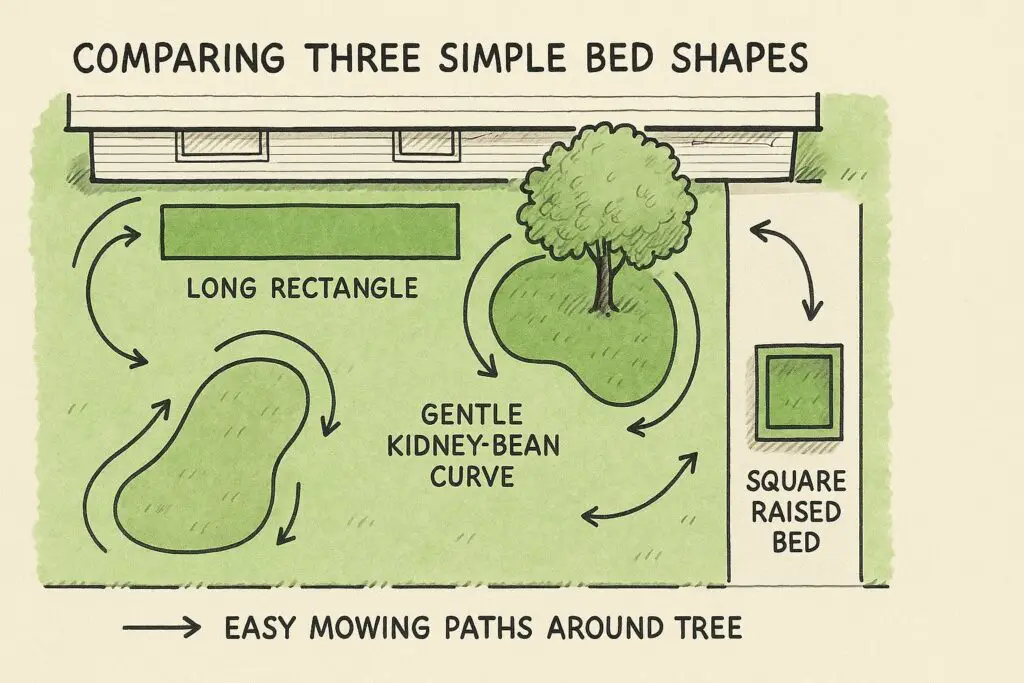
The shape and layout of your flower beds matter for maintenance. Complex designs with lots of tight corners are harder to edge and mow around. Simple, flowing shapes look great and save effort. Keep layouts uncomplicated for the easiest care. Practical designs are key for low maintenance front yard landscaping simple flower beds. Let’s look at some easy options.
Practical Examples of Simple Yet Visually Appealing Flower Bed Layouts
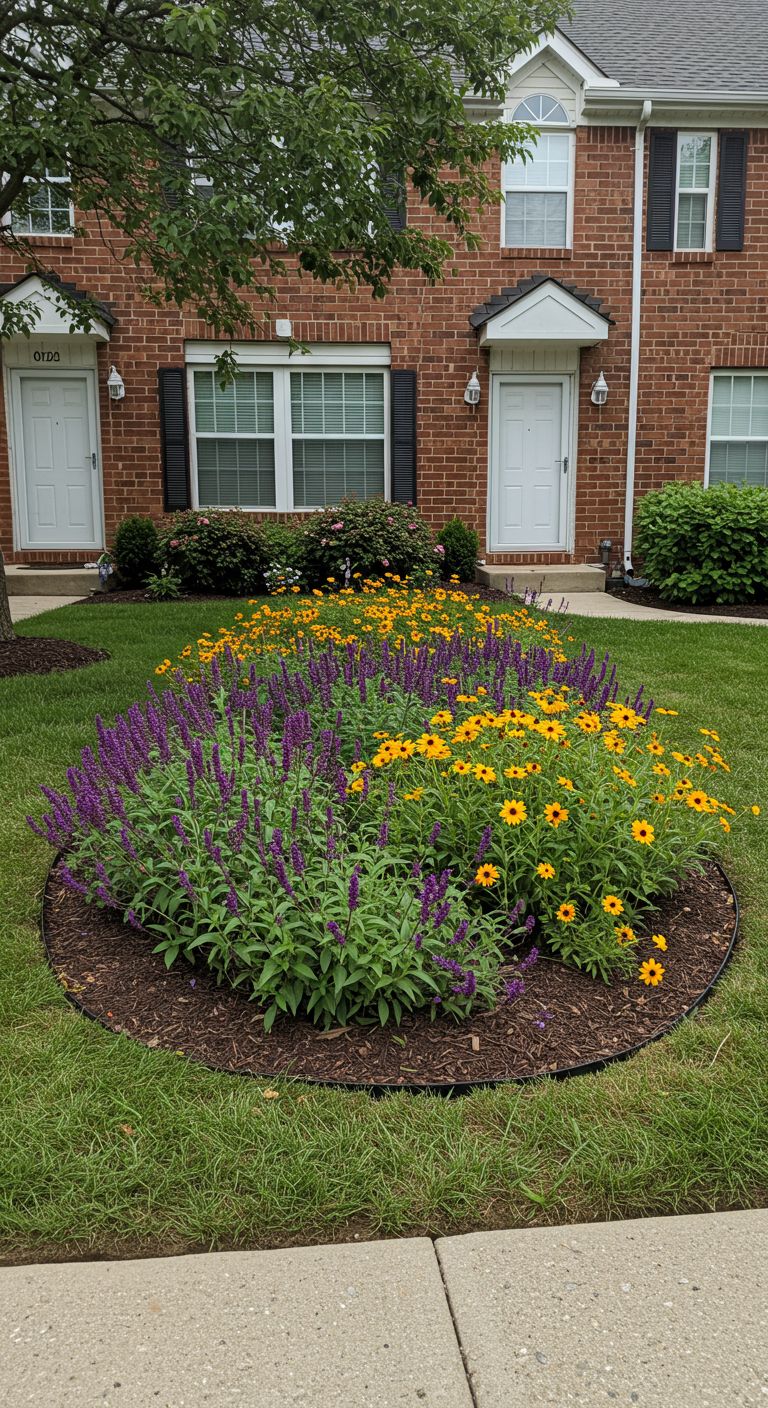
Think clean lines and gentle curves. Avoid zig-zags or lots of sharp angles. A simple rectangle along a porch or walkway is classic and easy. A wide, curving border following the lawn edge looks natural and flows nicely. Island beds in the lawn should be large enough to mow around easily. Grouping plants in simple blocks of color within the bed also looks good. Simplicity is elegant.
Rectangular Beds for Clean Lines and Minimal Upkeep
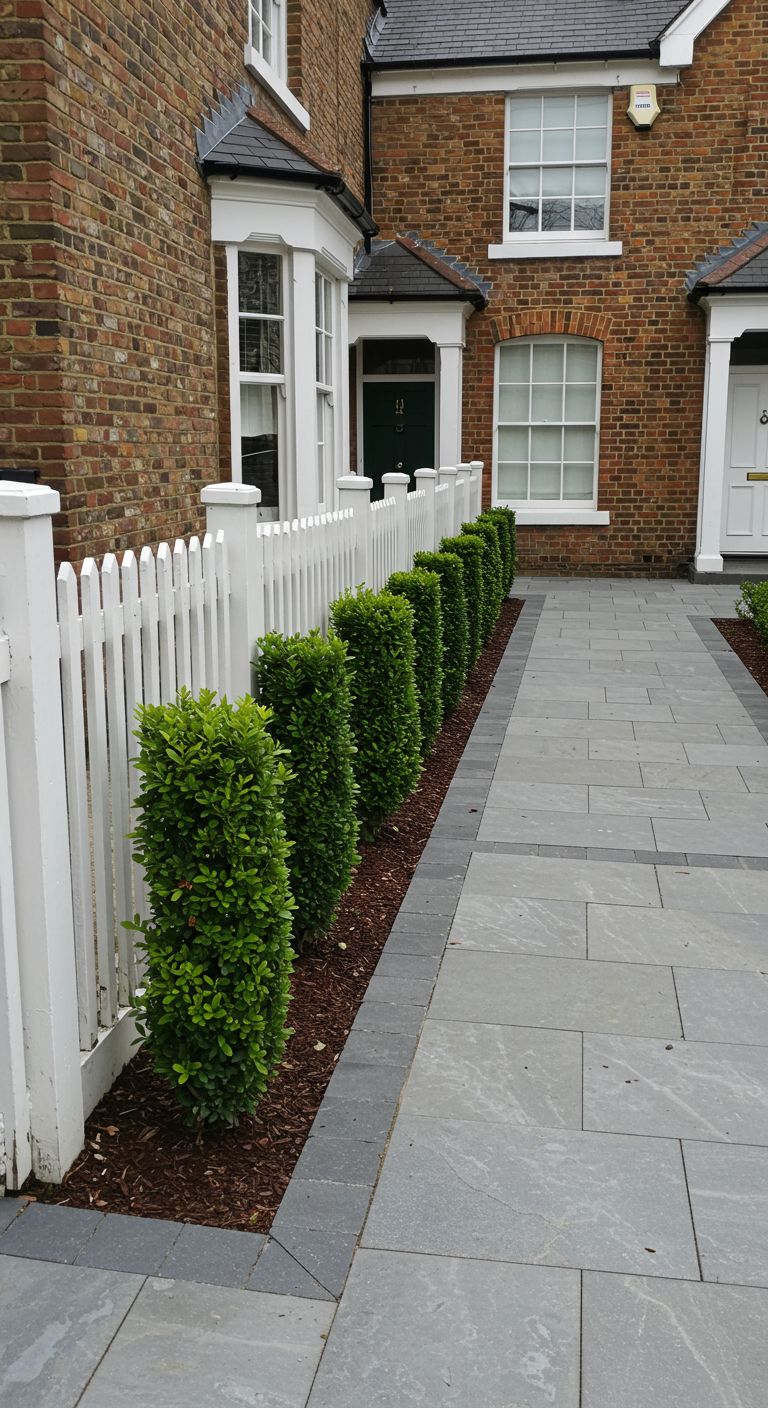
Rectangular beds are perhaps the easiest. They fit neatly against straight structures like houses, fences, driveways, and walkways. Their straight edges are simple to define with edging material. Mowing alongside a straight edge is quick and efficient. Rectangles offer a formal, tidy look. They are perfect for geometric designs or simple foundation plantings. Predictable and easy to manage. Front yard flower beds simple often start here.
Curved and Rounded Layouts for Visual Interest and Reduced Edge Maintenance
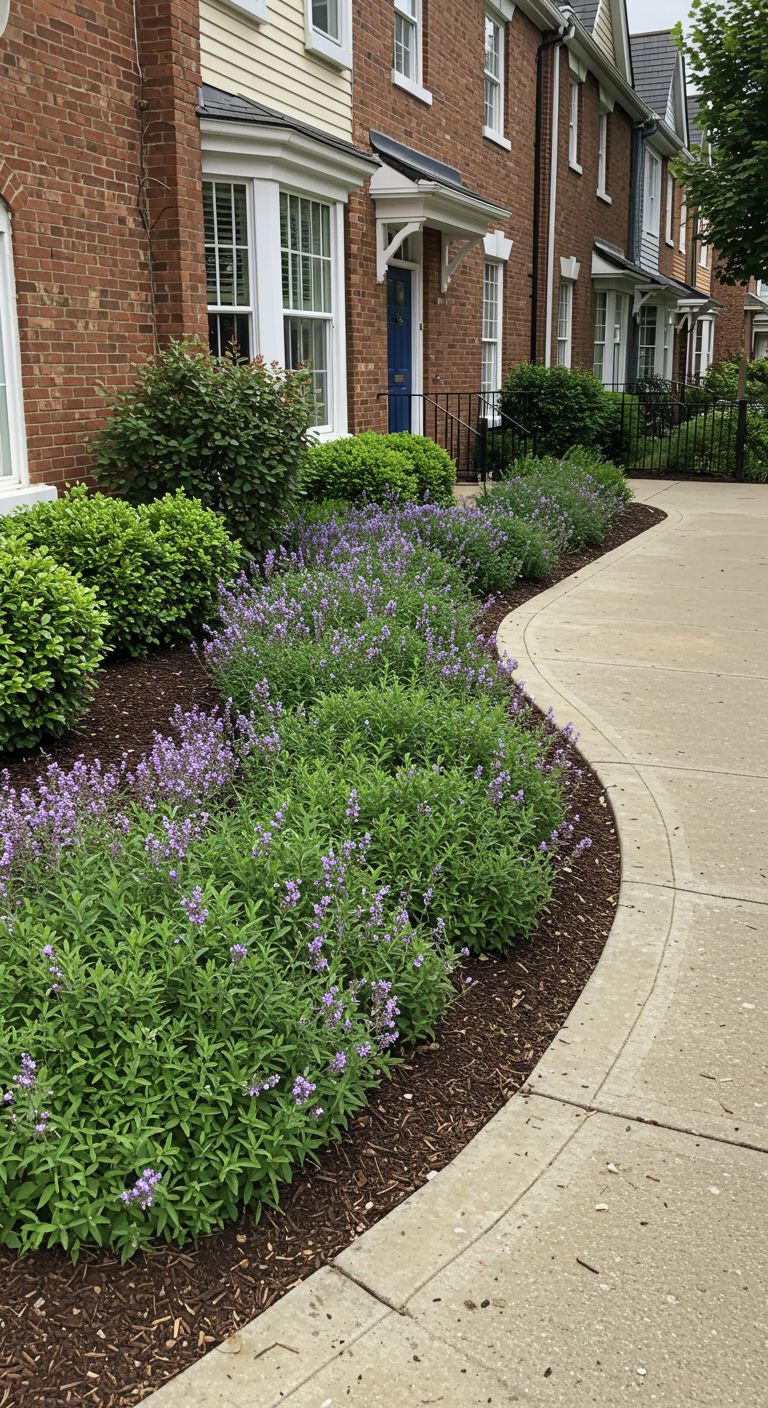
Gentle curved and rounded layouts soften the landscape. They create a more natural, flowing feel compared to straight lines. Broad, sweeping curves are easier to mow around than tight ones. Smooth edges can sometimes be maintained just by using a string trimmer carefully. Avoid very small or complex curves. Kidney shapes or simple arcs work well for island beds or softening corners. They add grace without adding much work.
Raised Flower Beds: Easy-Care Advantages and Simple Construction Tips
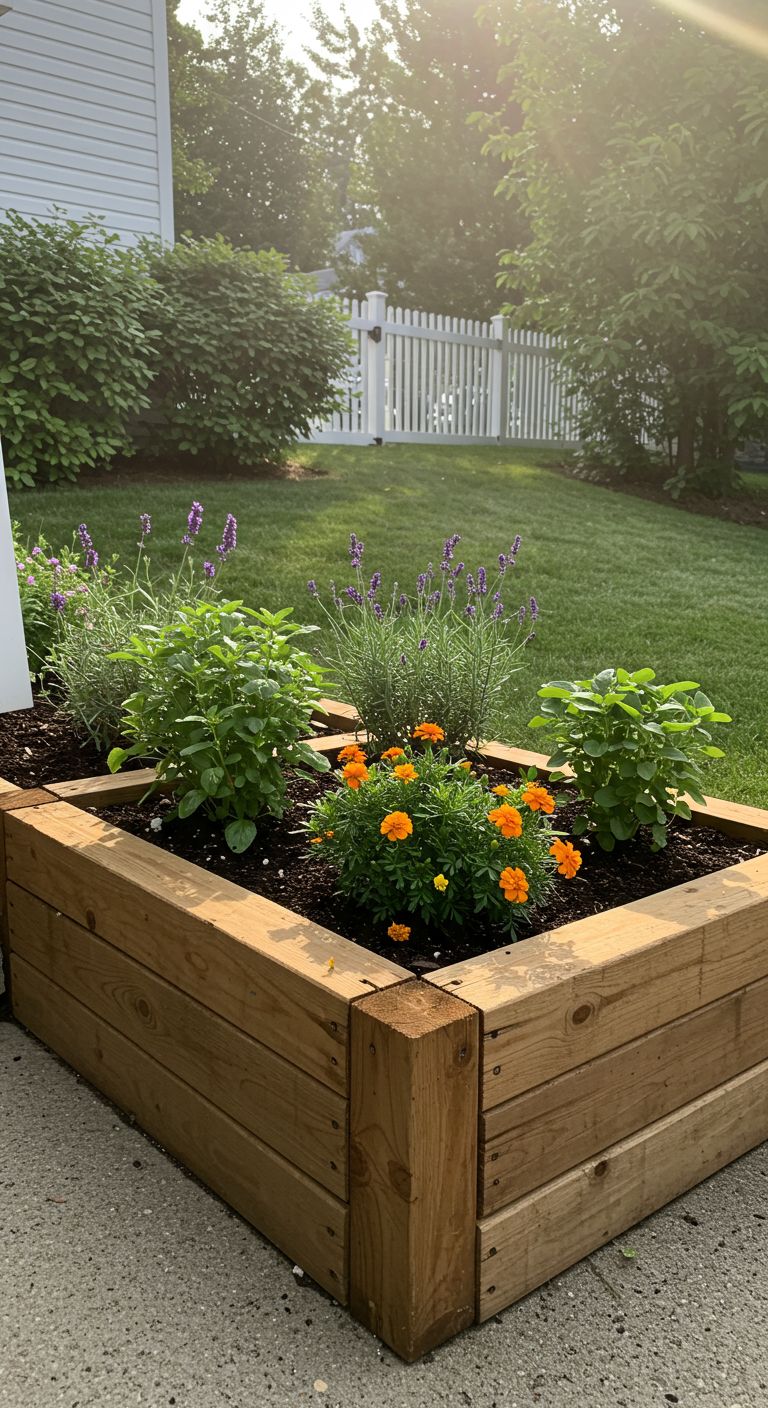
Raised flower beds lift the garden up. This improves drainage dramatically. It also means less bending over for planting and weeding – a huge plus! You control the soil completely. Fill them with good quality loam and compost. Building them can be simple. Use lumber (cedar or treated pine), landscape timbers, retaining wall blocks, or even large stones. Keep the shapes simple (squares, rectangles) for easy building and maintenance.
Tips & Tricks for Reducing Maintenance Further
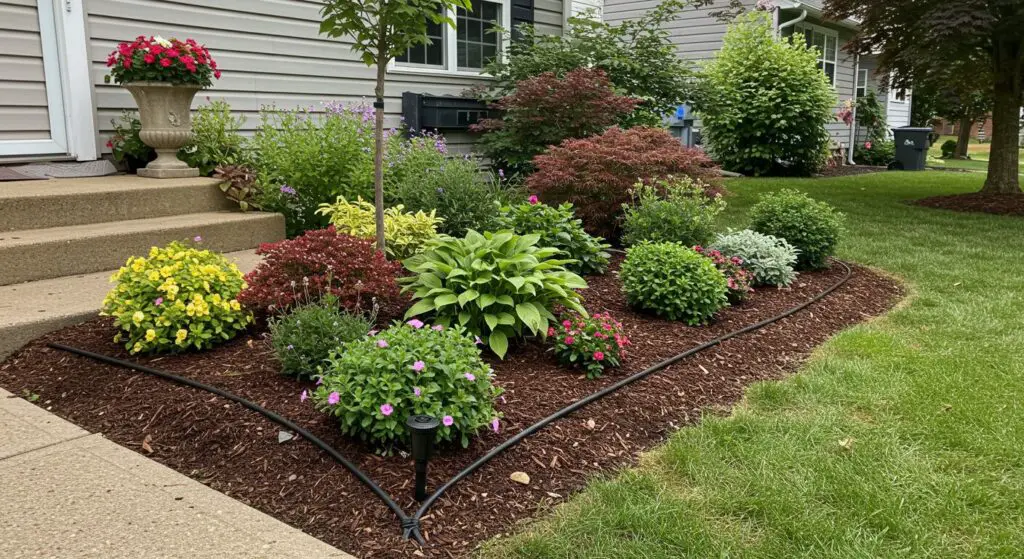
You’ve chosen easy plants, simple layouts, and embraced mulch. What else can cut down chores? A few more smart strategies exist. Think about efficient watering. Consider long-term feeding. Make seasonal choices work for you. These final touches help create truly low maintenance front yard landscaping design flower beds. Let’s make your garden work for you.
Implement Drip Irrigation or Soaker Hoses for Water-Efficient Care
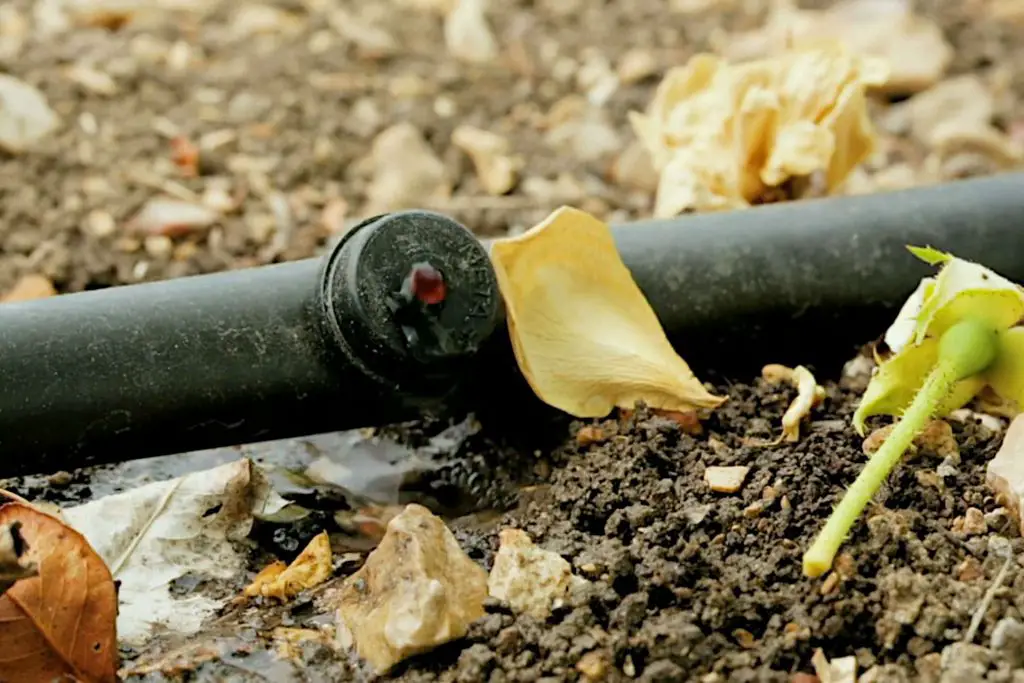
Hand watering takes time. Sprinklers can be wasteful, wetting leaves and encouraging disease. Consider drip irrigation or soaker hoses. Drip systems deliver water slowly, directly to plant roots. Soaker hoses weep water along their entire length. Both methods reduce water waste through evaporation. They keep foliage dry. And you can put them on timers for automated watering. Set it and forget it! Efficient and time-saving.
Use of Slow-Release Fertilizers or Compost for Healthier Plants with Less Effort
Constantly feeding plants is another chore. Use slow-release fertilizers. These coated pellets break down gradually, feeding plants over weeks or months. One application lasts much longer than water-soluble types. Even better? Amend your soil with compost. Good compost improves soil structure and provides gentle, long-term nutrients. Healthy soil grows healthy, resilient plants that need less supplemental feeding. Feed the soil, not just the plant.
Seasonal Plant Choices to Minimize Year-Round Gardening Chores
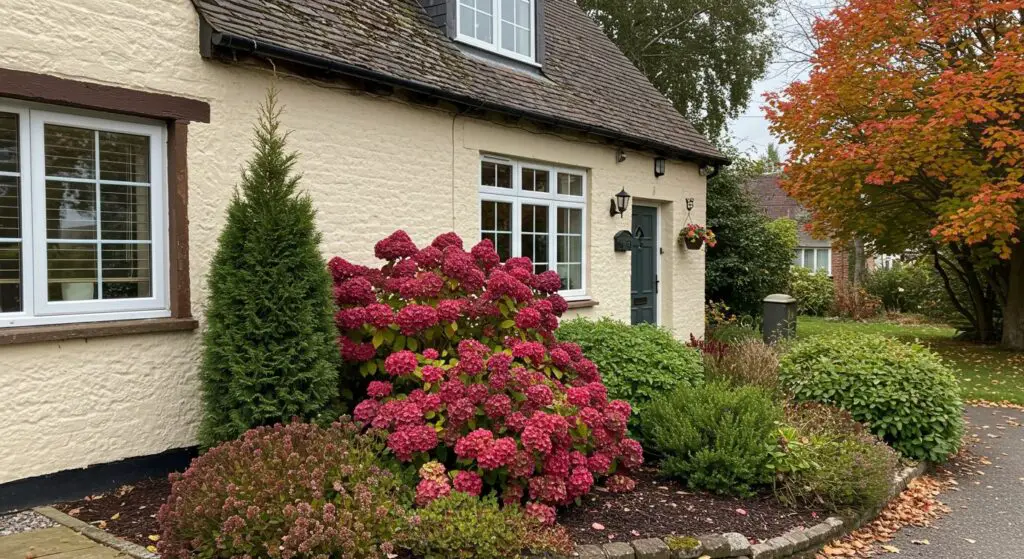
Think about the whole year. Choose plants that offer interest in multiple seasons. Shrubs with winter structure, spring flowers, and fall color give more bang for your buck. Rely heavily on hardy perennials and shrubs that come back reliably. Limit fussy annuals that need replanting every year, unless you truly enjoy that task. Select plants adapted to your climate that won’t need winter protection or excessive summer care. Smart seasonal plant choices mean less work overall.
Final Thoughts: Achieving a Beautiful, Easy-Care Front Yard
So there you have it. Creating that dream front yard doesn’t have to mean endless weekends lost to weeding and watering. It really is possible to have stunning flower beds without the constant upkeep. Remember the main points we covered. Simplicity is your friend. Clean lines and uncomplicated layouts make everything easier.
Choosing the right plants is super important. Focus on those hardy perennials, reliable shrubs, and useful groundcovers that thrive in your area without needing constant attention. And never underestimate the power of good planning and preparation. Thinking about spacing, soil, and sunlight before you plant saves so much effort down the road. Mulch is magical – use it!
Don’t feel intimidated. You can absolutely create beautiful, low-maintenance flower beds. It doesn’t matter if you are a new homeowner or just tired of too much garden work. Start small if you need to. Pick one area and transform it using these ideas.
Feel free to experiment. Adapt these tips to fit your own style and your specific yard conditions. Gardening should be enjoyable, not a burden. Go ahead, design that gorgeous, easy-care front yard you’ve been wanting. Enjoy the beauty without all the back-breaking work. You’ve got this!
